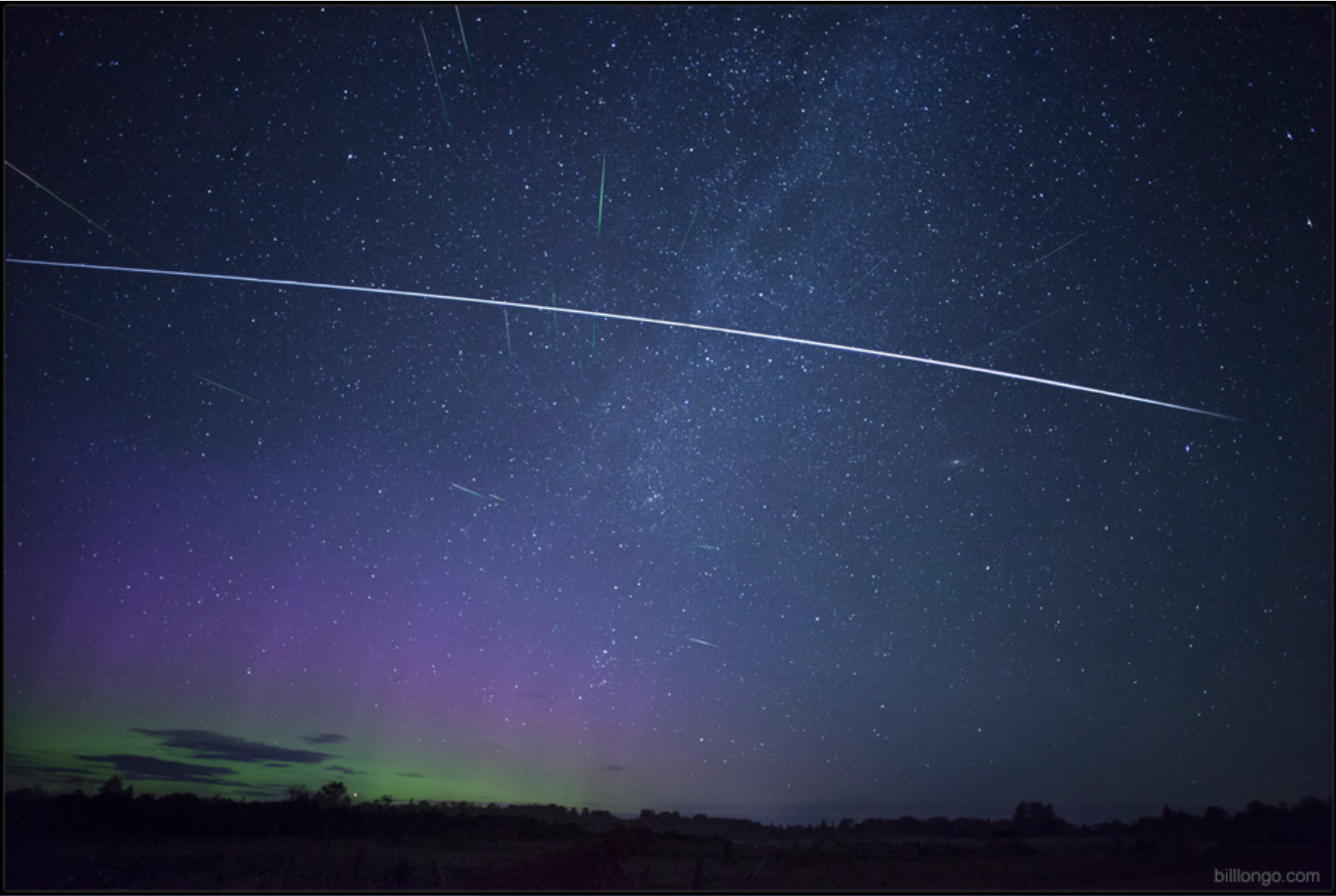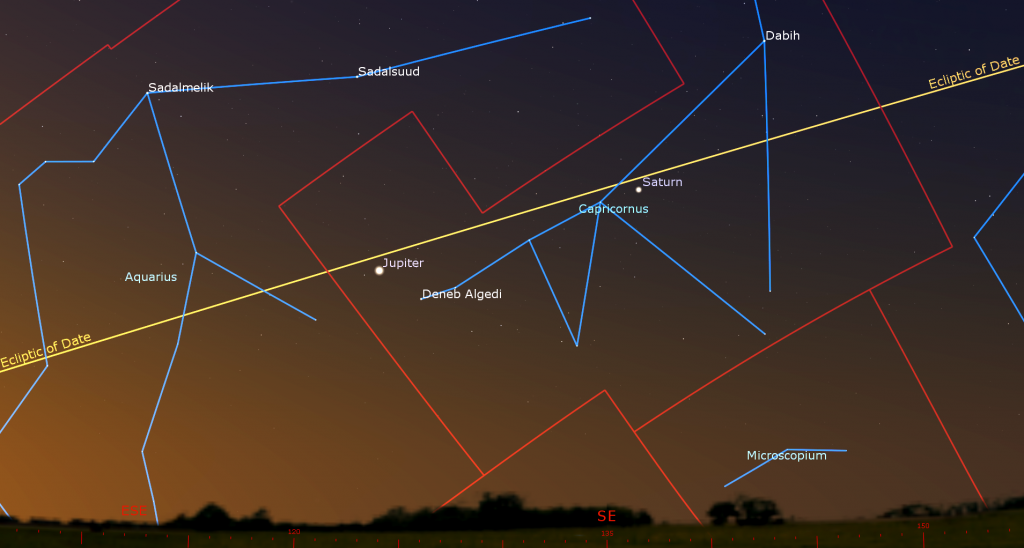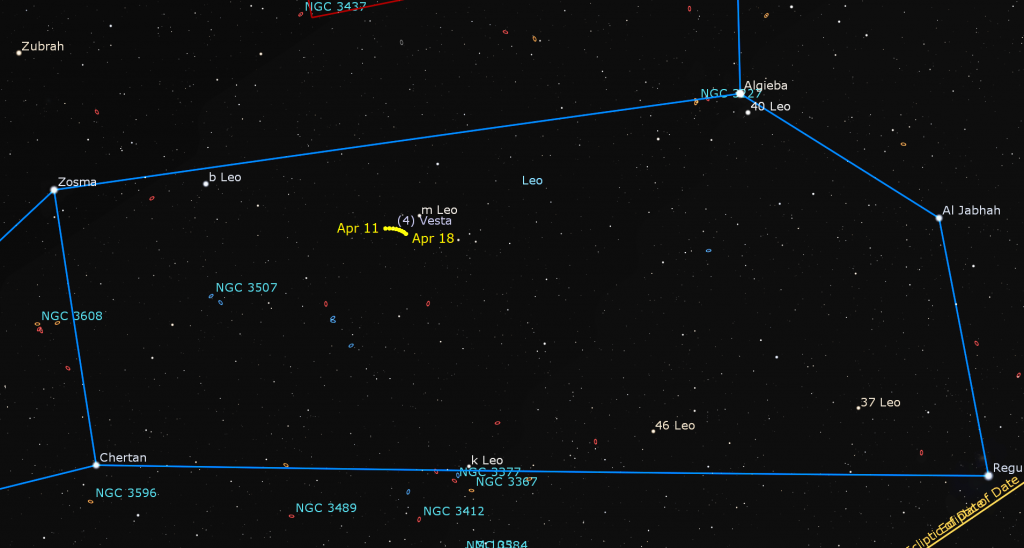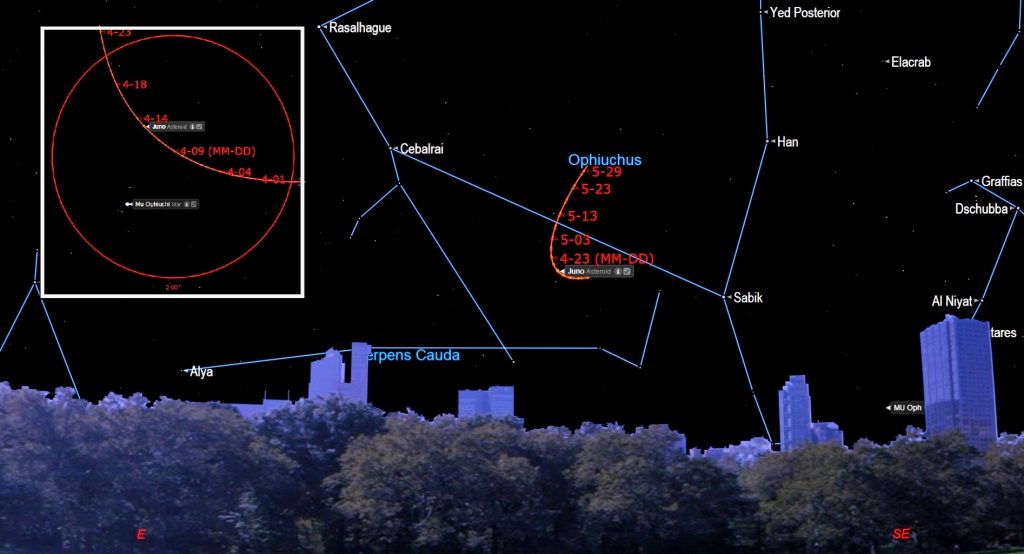A Meager Moon means more Galaxy-viewing, Mars Moseys through the Tips of Taurus, and Gas Giants Gleam before Dawn!

This amazing composite photo by my friend Bill Longo has it all! The arc of the International Space Station crossing the sky, the green glow of the Aurora Borealis, the northern Summer Milky Way, and numerous Perseids meteors!
Hello, Spring Stargazers!
Here are your Astronomy Skylights for the week of April 11th, 2021 by Chris Vaughan. Feel free to pass this along to your friends and send me your comments, questions, and suggested topics. You can also follow me on Twitter as @astrogeoguy! Unless otherwise noted, all times are expressed in Eastern Time. To subscribe to these emails please click this MailChimp link.
I can bring my Digital Starlab portable inflatable planetarium to your school or other daytime or evening event, or teach a session online. Contact me through AstroGeo.ca, and we’ll tour the Universe, or the Earth’s interior, together!
After passing new moon and initiating Ramadan today, the moon will return to view in the western post-sunset sky all around the world this week – but it won’t become bright enough or high enough to ruin our galaxy-chasing fun until next weekend. Check out last week’s Skylights for my recommended galaxies. Jupiter and Saturn will be spectacular in the eastern pre-dawn. In evening, Mars tops a triangle with its reddish doppelgangers Aldebaran and Betelgeuse, while bright Venus lurks above the post-sunset horizon! And two asteroids are easy to find. Read on for your Skylights!
The Moon and Ramadan
The moon will officially reach its new phase today (Sunday, April 11 at 10:30 pm EDT or 7:30 p.m. PDT). That translates to 02:30 Greenwich Mean Time (GMT) on Monday, April 12. While new, the moon is travelling between Earth and the sun. Since sunlight can only reach the far side of the moon, and the moon is in the same region of the sky as the sun, the moon becomes completely hidden from view from anywhere on Earth for about a day. After the new moon phase Earth’s celestial night-light will return to shine in the western evening sky.
This new moon will control the timing for Ramadan. The Islamic Calendar is lunar based and is not linked to the Earth-sun system. That causes it to shift (earlier) by about 10 days per year over time, compared to our Gregorian calendar. Each Islamic month commences when the Hilāl, or crescent moon, is first sighted in the western post-sunset sky from Mecca following a new moon phase. Mecca, or Makkah, is located east of the Red Sea in Saudi Arabia – at latitude 29° 25’ 21” North.

The month of Ramadan is the ninth month of the Islamic calendar. Observing Ramadan is regarded as one of the Five Pillars of Islam. Among other practices, observers are required to fast from sunrise to sunset. But the length of daylight varies considerably with latitude – so Muslims living at high northern latitudes, where the days can reach 22 hours in length in summer, follow the timetable of Mecca, where the days are only about 12 hours and 40 minutes in length during April. (That situation will repeat for Southern Hemisphere Muslims in years when Ramadan follows their spring equinox in September.)
In 2021 Ramadan will commence at sundown on Monday, April 12. The moon spotters might also notice bright Venus shining only two finger widths to the right of the moon! The holiday of Eid al-Fitr, or just Eid, marks the end of the month Ramadan and the beginning of Shawwal, the next Islamic lunar month – this year that’s on Tuesday, May 12.
For us regular moon-watchers, the slim crescent of the young moon will start to capture our attention us on Tuesday evening. The upright angle of the evening ecliptic (and therefore the moon’s orbit) will tip the moon sideways while it sets – placing the lit crescent at the bottom of the moon, like the smile of the Cheshire Cat.
For the rest of the week, the moon will wax fuller in illuminated phase and climb away from the sun. From Wednesday to Saturday, the moon will traverse the lengthy constellation of Taurus (the Bull). The moon will shine in a dark sky then, allowing observers worldwide to see it pass close to the right (celestial north) of the Hyades star cluster on Thursday. That cluster, plus the bright, reddish star Aldebaran marking his southern eye, forms the triangular face of the bull. At 67 light-years from our sun, Aldebaran is not part of the Hyades, which are twice as far away. Look for the bright little Pleiades star cluster sitting a fist’s diameter to the right (northwest) of the moon and the bull’s-eye!
On Friday and Saturday night, the moon will hop upwards – passing Mars, which is located between the bull’s horn-tips. On Friday night the moon will sit a slim palm’s width below (or 5.5° to the celestial west of) Mars. The following night, the moon will be the same distance to Mars’ upper left (celestial east).

Once the sky has darkened after sunset on Saturday, train your binoculars on the moon and look for a dense clump of dim stars sitting a lunar diameter to the moon’s lower left (or 0.5° to the celestial south). That’s an open star cluster in Gemini (the Twins) called Messier 35 or the Shoe-Buckle Cluster. A curved line of bright stars named Tejat, Propus, and 1 Geminorum, which form the westerly twin Castor’s foot, can help you find Messier 35 again on a subsequent moonless evening.
The moon will end the week next Sunday night sitting as a nearly half-illuminated orb in the centre of Gemini, and setting in the west during the wee hours.
The Planets
Saturn and Jupiter are both shining in the southeastern pre-dawn sky while they travel slowly eastwards through the dim stars of Capricornus (the Sea-Goat). At the same time, the westward drift of the entire sky due to Earth’s motion around the sun are causing everything to rise a few minutes earlier every morning.

This week, yellowish, medium-bright Saturn will rise in a dark sky shortly before 4 am local time. Much whiter and brighter Jupiter will join the ringed planet about 30 minutes later. Magnitude -2.15 Jupiter shines about 14 times brighter than magnitude +0.75 Saturn. Jupiter will sit about 1.5 fist diameters to Saturn’s lower left (or 14° to the east) this week. Because Jupiter orbits closer to the sun than Saturn, it has a faster eastward motion – so the two planets are continuously increasing their separation from one another.
Due to the very shallow angle of the morning ecliptic in springtime, Jupiter doesn’t get very high above the horizon before the dawn sky brightens, especially in mid-Northern latitudes. That makes it hard to obtain sharp views of the planet in a telescope. Since the ecliptic is more vertical for observers at southerly latitudes, both planets will be higher and clearer in telescopes. If you are willing to try getting up early and taking your backyard telescope outside, the Great Red Spot will be visible on Jupiter on Monday and Sunday morning.

This week, Mars will be the only planet visible during evenings. The Red Planet has been continuing to trek eastward between the lengthy horns of Taurus (the Bull). Once the sky darkens, at around 9 pm local time, the tiny, reddish dot of Mars will be located almost halfway up the western sky. Combine Mars with two similar-looking bright stars to form a large, tilted triangle in the western sky. Mars sits at the top (northeastern) corner. Reddish Aldebaran in Taurus (the Bull) is almost two fist diameters below (or 16 degrees to the celestial southwest of) Mars. And bright Betelgeuse in Orion (the Hunter) is located almost two fist diameters to Mars’ lower left (or 17 degrees to the celestial south). As Mars moseys along its orbit, that triangle will narrow. Despite Mars being much farther from Earth now, our telescope will still show its small, ruddy disk. Look early – Mars will set in the west shortly after 1 am local time.
Venus has now entered the western post-sunset sky – but it won’t swing wide enough of the sun to easily see its bright point of light until late this week and beyond. We’ll have Venus as the “Evening Star” for the rest of 2021. Mercury will pass close to Venus toward the end of April.

A relatively bright asteroid designated (4) Vesta has been traveling through the interior of Leo (the Lion) recently, and it’s nicely placed for viewing all evening in the southern sky. This week, magnitude 6.5 Vesta will trace out a short curve near a brighter star named m Leonis (or m Leo or 51 Leo). In binoculars, Vesta will be a small speck sitting just half a finger’s width (or one moon diameter) to the lower left of the star. m Leo is located about halfway along the lion’s back, and a finger’s width below the line joining the bright stars Algieba and Zosma. If you use m Leo to locate and view Vesta in your telescope, remember that a reflector telescope will flip Vesta to underneath the star. If you have the opportunity, aim your telescope at Algieba and see if you can split it into a nice blue and gold double star!
On Tuesday, the main belt asteroid designated (3) Juno will cease its own regular eastward motion across the distant stars of Ophiuchus (the Serpent-Bearer) and begin a westward retrograde loop that will last until early August. That night, the faint, magnitude 10.8 asteroid will rise just before midnight and then remain visible until the pre-dawn while it crosses the sky less than a finger’s width from the medium-bright star Mu Ophiuchi (or μ Oph). If you use that star to locate and view Juno in your telescope, remember that a reflector telescope will flip Juno to underneath the star.

It’s (Still) Spring Galaxy Time!
Although the moon will return to the evening sky this week, its thin crescent will be setting in early evening, allowing for more galaxy-viewing. If you missed my tour through the best galaxies to view, it’s posted here.
The March-April, 2021 issue of SkyNews Magazine contains an article I wrote about spring galaxy-viewing. Check your newsstands. Their upcoming May-June issue will include my story about galaxies that are tucked close-in to bright stars, allowing anyone to easily find them with a manual telescope. You can read a free supplement to that story here: https://skynews.ca/great-april-galactic-adventures/.
Lyrids Meteor Shower
The annual Lyrids meteor shower, derived from particles dropped by comet C/1861 G1 (Thatcher), runs from April 16 to 30 and will peak in intensity before dawn on Thursday, April 22, worldwide – so you can start to keep an eye out for some meteors as the shower period opens this weekend. The Lyrids shower can deliver up to 18 meteors per hour, with occasional fireballs. True Lyrids will appear to be travelling away from a point in space (the shower’s radiant) near the bright star Vega, which will be high in the eastern sky before dawn. This year, the moon will be in the sky for most of the night during the peak night, leaving skies less than ideal for meteor-watching. I’ll share some tips for seeing them next week.
Public Astro-Themed Events
Every Monday evening, York University’s Allan I. Carswell Observatory runs an online star party – broadcasting views from four telescopes/cameras, answering viewer questions, and taking requests! Details are here. Their in-person Wednesday night viewing has been converted to online via the observatory YouTube channel, where they offer free online viewing through their rooftop telescopes, including their 1-metre telescope! Details are here.
During mornings from April 12 to 16, my friend Dr. Bhairavi Shankar of Indus Space is offering a virtual program called All Things Space. It’s for Grades 1-3 youth interested in STEAM and new to the topics of Space Science and Exploration. Details are here. During the afternoons that week, Indus Space is also offering Space Engineer’s Virtual Camp. It’s designed for youth in Grades 6-8, who will explore different types of engineering skills and projects that are important to outer space exploration. Details are here.
On Monday, Wednesday, and Friday this week, Richmond Hill’s David Dunlap Observatory and RASC Toronto Centre are teaming up to offer ONLINE 2-hour “School Break” sessions for kids and families! I’m hosting the Friday session. Details and the registration links are here for Monday morning, here for Wednesday afternoon, and here for Friday afternoon. A modest fee goes to support our ongoing efforts to deliver public programs at DDO.
On Monday night, April 12 at 7:30 pm EDT, Plateau Astro and CanadaMoon are hosting Yuri’s Night. On the 60th anniversary of Yuri Gagarin’s first orbit around Earth, tune in for a free, fun, live interview showcase of Canadian space experts, including Canadian Space Agency astronaut, Dr. Robert Thirsk, Dr. Natalie Ouellette, Canadarm specialist Kristen Facciol, and many more! More details are here, and watch the event on YouTube here.
My free, family-friendly Insider’s Guide to the Galaxy webcasts with Jenna Hinds of RASC National returns on Tuesday afternoon, April 13 at 3:30 pm EDT. We’re going to do a “March Break” session, and cover topics like Harry Potter connections to astronomy, how to make and use a starfinder and measure the sky with your hand, share star stories, and more! You can find more details, and the schedule of future sessions, here and here.
On Thursday, April 15 from noon to 12:30 pm, RASC National will continue their new weekly moon-observing series the Moon at Noon featuring Jenna Hinds and guests. Details are here and the registration link is here! Sessions will also be livestreamed to YouTube here and can be watched at any time.
On Sunday afternoon, April 25 from 1 to 2 pm EDT I’m hosting an online session for RASC called Ask an Astronomer! We’ll explore the night sky together and answer your astronomy and space-related questions in simple language – using pictures, illustrations and planetarium software. The deadline to register is Friday, April 23 at 3:00 pm. Registration is here. A modest fee goes to support our ongoing efforts to deliver public programs at DDO.
Space Station Flyovers
There are no visible ISS (or International Space Station) passes over the GTA this week. It will return with pre-dawn passes starting April 25.
Keep looking up, and enjoy the sky when you do. I love questions and requests. Send me some!